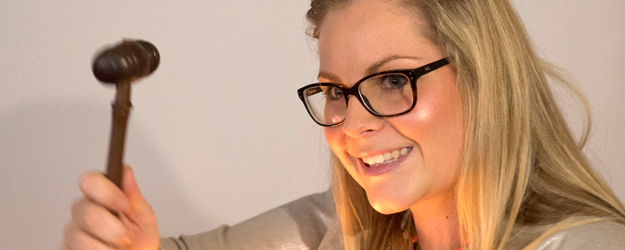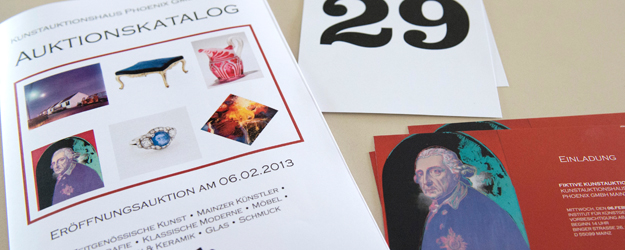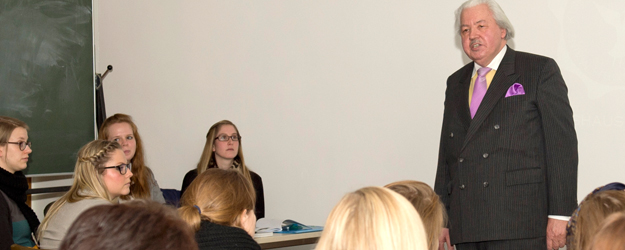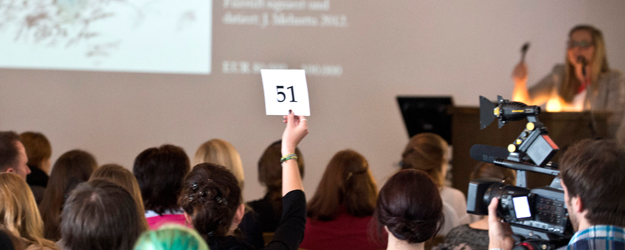8 February 2013
A group of 56 students staged a major auction at the Institute of Art History of Johannes Gutenberg University Mainz (JGU). Their fictitious auction houses, Phoenix and Galla, offered works ranging from Otto Dix and Salvador Dali to Andy Warhol and George Grosz – bringing in nearly EUR 6 million in bids from the public. A tremendous success, even if no real money changed hands.
Dr. Benno Lehmann is standing in front of live cameras, holding court: "Yes, we're very satisfied with our sales. After all, the auction houses will be retaining 40 percent of the proceeds. So we will be carrying on with our successful activities." The art historian and former business studies major is sticking to his role. After all, the simulation is intended to be as authentic as possible.
"We're coming to the crown jewel of our auction," announces auctioneer Jennifer Keck. Listed as number 054, the Phoenix GmbH auction house is putting up Andy Warhol's “Fredrick the Great” for sale. "The telephone lines to the United States are open," Keck declares from behind her podium, the auctioneer’s hammer poised in her left hand. "But it would certainly be great if Andy didn't make the trip to America."
EUR 1,700,000 for the Prussian king
There are students sitting in the audience, joined by a number of artists from the region whose works are up for sale. A few curiosity seekers have also found their way into seats. The artworks are present only in the form of photos within a PowerPoint presentation, but this reflects standard auction house practice.
And now the customers start placing bids, raising numbered cards in the air. The bidding starts at EUR 700,000 and quickly heads upwards. The mark of one million is soon passed. "I'd guess that pretty much blows out a student's budget," Keck jokes. "EUR 1,200,000... EUR 1,300,000...." The bid for Warhol's Prussian king finally settles at a hefty figure. "EUR 1,700,000 going once, going twice, and for EUR 1,700,000, the Warhol goes to bidder number ..." Unsurprisingly, the buyer prefers to remain anonymous.
This auction is being staged by 56 students in Dr. Benno Lehmann's project seminar "Introduction to the Art Market — International and national auction houses as intermediaries on the art market." The JGU students of art history were responsible for all aspects of the simulation. This started with acquiring the works of art, even if the pieces were never really going to come under the hammer. They also produced two catalogs, handling all design and layout questions. The students even established a press office and a legal division.
Art market is rarely discussed
"We designed the project to correspond as closely as possible to reality," Lehmann claims. He sees it as a personal priority to introduce students to this aspect of the business. "The art market is typically neglected in art history classes because it's the side that deals with money – and many professors avoid that side like the devil avoids holy water." Lehmann is currently the only one addressing and teaching on this topic in earnest.
It definitely is a crucial issue. "The art market is much, much older than art history. It's got roughly 3,000 years under its belt, while art history stretches back only 200, maybe 250 years." Money and art have long belonged together. "And the future is with auction houses." They are the global players, and their influence on prices and the market is increasing. They are also potential employers for art historians, a factor that shouldn't be ignored. More than enough reason to familiarize students with how they work. "They could go work for an auction house immediately after taking this seminar," Lehmann promises.
"We really went to visit artists in their ateliers to talk about a selection of their works," explains Natascha Gross. She was responsible for both acquisitions and press work. They were limited to artworks not currently on display in museums. Preferably works that are already slated for auction in the near future – like the Warhol piece.
From acquisition to fine print
Acquisition is just one step in the process. There was a lot of other work to do for the two fictitious auction houses Galla and Phoenix. Starters, fliers, and posters had to be produced. There were also legal issues requiring clarification. They turned up as the small print in the catalog. "The first issue to deal with was the legal form of the auction houses," explains Nadine Nitsche. "We also had to establish the terms and conditions for the auction and the terms of assignment. You have to protect yourself against all contingencies. One single error can cost a lot of money."
Dr. Benno Lehmann served as an advisor throughout the process. The art historian and business studies graduate once also studied law and business management. This put him in a strong position to give advice on tricky areas stretching across different disciplines. "He let his own experiences flow into the seminar and gave us a lot of tips," says auctioneer Jennifer Keck. "But he also left us room to learn and develop on our own."
Keck found participation in the seminar to be a unique experience. "It's the first time that I've had the chance to get involved with this level of hands-on work. In my opinion this type of thing isn't offered nearly enough. We learned more here than we can learn in any classroom and it may well be very useful later during our working careers. I got more out of this than I otherwise normally would from three semesters combined." She also discovered that auctioneering is hard on the voice. "We just spent 20 minutes practicing, it's really tiring."
First auction, then courtroom
Lehmann is firmly convinced: "Theory alone isn't enough. The mechanisms of the art market have to be made tangible to the young people, and this is the best way to do that."
He feels he succeeded at this and already has big plans for next semester: "We'll delve into the criminal side of the art market and look at theft of artworks, forgeries, and restitution. We'll have a grand courtroom proceeding and even the Russian Mafia will have their fingers in the pie." With the next simulation already in the pipeline, Lehmann certainly won't have a hard time gathering participants. That much is clear from the satisfied faces of the students. The majority of them will almost certainly be back for more.




